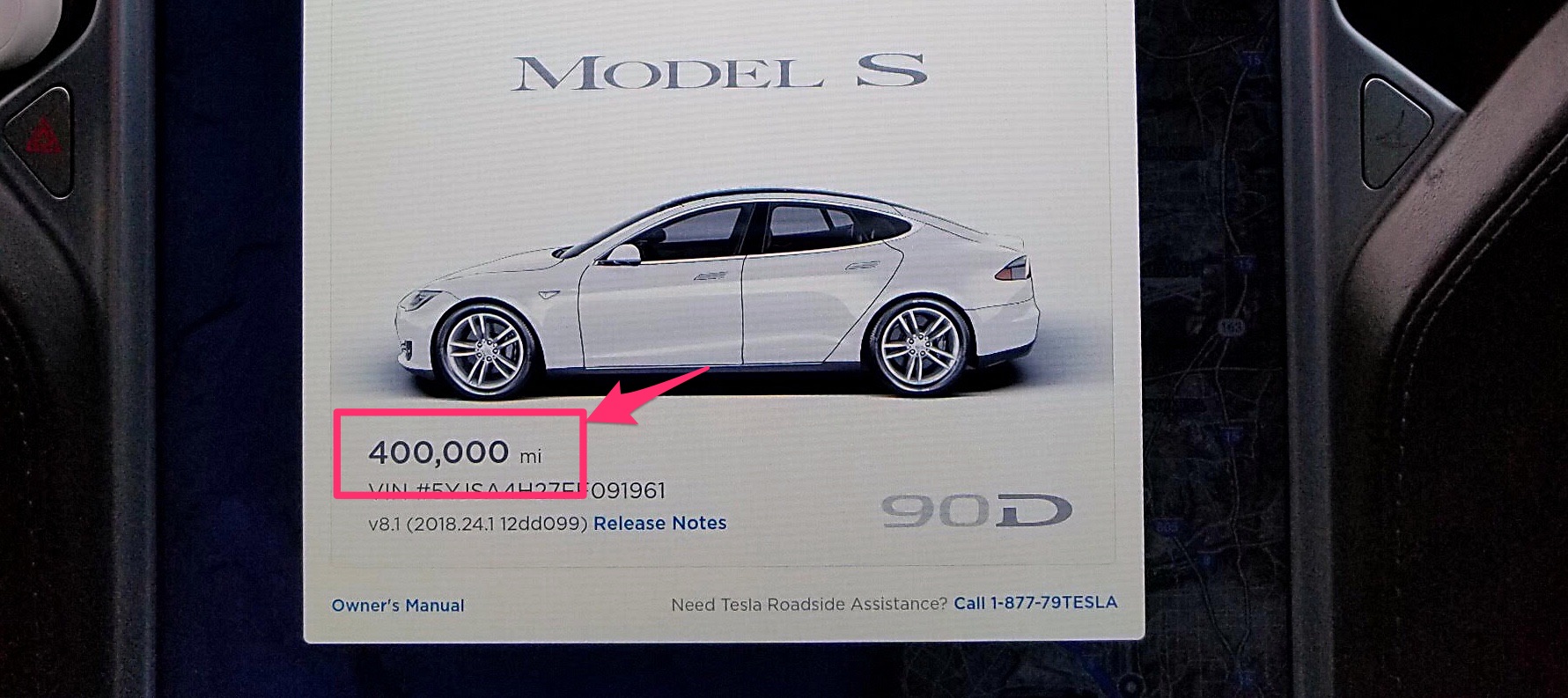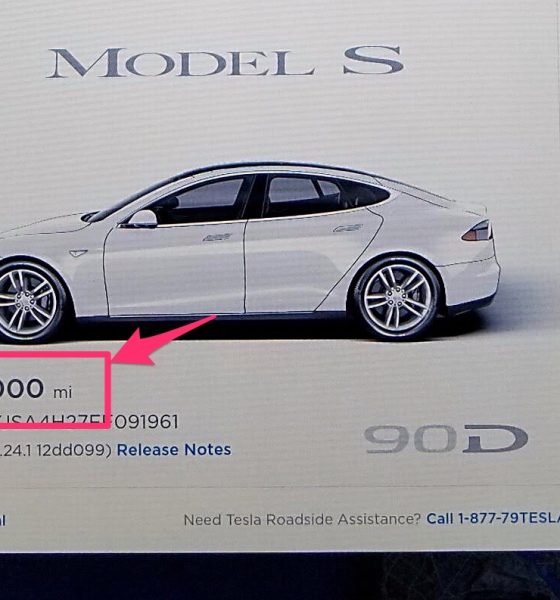

News
Tales from a Tesla Model S that hit 400,000 miles in 3 years
Tesloop, a Tesla-only intercity shuttle service for Southern California commuters, has reached another milestone with its Model S 90D. In a recent announcement, the company revealed that their Model S, dubbed eHawk, has passed the 400,000-mile mark, making it as one of the highest mileage Teslas in the world today.
eHawk entered service on July 2015, driving from city to city in Southern California and Nevada. By February 2016, the Model S 90D had logged its first 100,000 miles, and by August that year, the full-sized family sedan passed the 200,000-mile mark. In a recent blog post, Tesloop stated that roughly 90% of eHawk’s trips were driven using Autopilot, with Pilots (as the company refers to its drivers) only taking over active driving duties when needed. Tesloop’s Model S 90D currently travels an average of 17,000 miles per month. On the company’s recent post, Haydn Sonnad, Tesloop’s founder, expressed his optimism for the coming years.
“Vehicle connectivity is about to transform the car ownership and user experience. We are close to the point where increasingly sophisticated autonomous driving features and deep connectivity are coupled with electric drivetrains that last hundreds of thousands of miles, a whole new approach to mobility can be offered, that will transform the economics of car ownership and usage, while offering a greatly superior customer experience,” he said.
Over the past 3 years and through 400,000 miles on the road, eHawk has accumulated roughly $19,000 worth of maintenance costs, equating to about $0.05 per miles. This cost is broken down to $6,700 for general vehicle repairs and $12,200 for regularly scheduled maintenance. According to the company’s estimates, a Lincoln Town Car or a Mercedes-Benz GLS class would have accumulated maintenance costs of $88,500 ($0.22/mile) and $98,900 ($0.25/mile), respectively, had the vehicles been driven for 400,000 miles.
The Model S 90D’s high voltage (HV) battery unit was replaced twice under warranty since July 2015. The first battery HV battery replacement was at 194,000 miles, while the second was at 324,000 miles. Average battery degradation over the vehicle’s first 194,000 miles was around 6% with multiple Supercharger stops every day. Between 194,000 – 324,000 miles, the HV battery degradation was estimated at around 22%. According to Tesloop, this was likely due to the company’s practice of constantly charging eHawk to 95-100%, instead of Tesla’s recommended 90-95%. On its blog post, Tesloop shared Tesla’s reminder to the company after its first HV battery replacement.
“Found internal imbalance in HV battery due to consistent supercharging to 100% from a low state of charge (SOC) without any rest periods in between. HV battery has been approved to be replaced. Also recommend that customer does not Supercharge on a regular basis and does not charge to 100% on a regular basis. We also recommend that the customer use scheduled charging to start charge 3 hours after end of drive at low SOC.”

The interior of Tesloop’s Tesla Model S 90D after being in service for 400,000 miles. [Credit: Tesloop]
Apart from its HV battery, Tesloop’s Model S 90D also had its front drive unit replaced under warranty at 36,000 miles. No issues with the vehicle’s drive units have emerged since. The Tesla-exclusive shuttle service also opted to upgrade the rear seating of eHawk to the executive seat option for maximum passenger comfort. According to the company, the seats have held up well over the thousands of passengers the electric car has transported over the years.
Considering the endurance showcased by its Model S 90D, Tesloop estimates that eHawk should be able to last another 600,000 miles over the next five years. If the vehicle achieves this, it would be the first Tesla Model S to reach the 1 million-mile mark.
Tesloop currently operates a fleet of Model S and Model X vehicles. One of its Model X, a 90D named Rex, also achieved its own milestone last month, after it hit 300,000 miles on the road since being deployed. When the all-electric SUV reached the 300,000-mile mark, its battery degradation was estimated at roughly 10%. Since achieving its milestone, however, Tesla has changed the vehicle’s rear drive unit.

News
Tesla FSD fleet is nearing 7 billion total miles, including 2.5 billion city miles
As can be seen on Tesla’s official FSD webpage, vehicles equipped with the system have now navigated over 6.99 billion miles.

Tesla’s Full Self-Driving (Supervised) fleet is closing in on almost 7 billion total miles driven, as per data posted by the company on its official FSD webpage.
These figures hint at the massive scale of data fueling Tesla’s rapid FSD improvements, which have been quite notable as of late.
FSD mileage milestones
As can be seen on Tesla’s official FSD webpage, vehicles equipped with the system have now navigated over 6.99 billion miles. Tesla owner and avid FSD tester Whole Mars Catalog also shared a screenshot indicating that from the nearly 7 billion miles traveled by the FSD fleet, more than 2.5 billion miles were driven inside cities.
City miles are particularly valuable for complex urban scenarios like unprotected turns, pedestrian interactions, and traffic lights. This is also the difference-maker for FSD, as only complex solutions, such as Waymo’s self-driving taxis, operate similarly on inner-city streets. And even then, incidents such as the San Francisco blackouts have proven challenging for sensor-rich vehicles like Waymos.
Tesla’s data edge
Tesla has a number of advantages in the autonomous vehicle sector, one of which is the size of its fleet and the number of vehicles training FSD on real-world roads. Tesla’s nearly 7 billion FSD miles then allow the company to roll out updates that make its vehicles behave like they are being driven by experienced drivers, even if they are operating on their own.
So notable are Tesla’s improvements to FSD that NVIDIA Director of Robotics Jim Fan, after experiencing FSD v14, noted that the system is the first AI that passes what he described as a “Physical Turing Test.”
“Despite knowing exactly how robot learning works, I still find it magical watching the steering wheel turn by itself. First it feels surreal, next it becomes routine. Then, like the smartphone, taking it away actively hurts. This is how humanity gets rewired and glued to god-like technologies,” Fan wrote in a post on X.
News
Tesla starts showing how FSD will change lives in Europe
Local officials tested the system on narrow country roads and were impressed by FSD’s smooth, human-like driving, with some calling the service a game-changer for everyday life in areas that are far from urban centers.

Tesla has launched Europe’s first public shuttle service using Full Self-Driving (Supervised) in the rural Eifelkreis Bitburg-Prüm region of Germany, demonstrating how the technology can restore independence and mobility for people who struggle with limited transport options.
Local officials tested the system on narrow country roads and were impressed by FSD’s smooth, human-like driving, with some calling the service a game-changer for everyday life in areas that are far from urban centers.
Officials see real impact on rural residents
Arzfeld Mayor Johannes Kuhl and District Administrator Andreas Kruppert personally tested the Tesla shuttle service. This allowed them to see just how well FSD navigated winding lanes and rural roads confidently. Kruppert said, “Autonomous driving sounds like science fiction to many, but we simply see here that it works totally well in rural regions too.” Kuhl, for his part, also noted that FSD “feels like a very experienced driver.”
The pilot complements the area’s “Citizen Bus” program, which provides on-demand rides for elderly residents who can no longer drive themselves. Tesla Europe shared a video of a demonstration of the service, highlighting how FSD gives people their freedom back, even in places where public transport is not as prevalent.
What the Ministry for Economic Affairs and Transport says
Rhineland-Palatinate’s Minister Daniela Schmitt supported the project, praising the collaboration that made this “first of its kind in Europe” possible. As per the ministry, the rural rollout for the service shows FSD’s potential beyond major cities, and it delivers tangible benefits like grocery runs, doctor visits, and social connections for isolated residents.
“Reliable and flexible mobility is especially vital in rural areas. With the launch of a shuttle service using self-driving vehicles (FSD supervised) by Tesla in the Eifelkreis Bitburg-Prüm, an innovative pilot project is now getting underway that complements local community bus services. It is the first project of its kind in Europe.
“The result is a real gain for rural mobility: greater accessibility, more flexibility and tangible benefits for everyday life. A strong signal for innovation, cooperation and future-oriented mobility beyond urban centers,” the ministry wrote in a LinkedIn post.
News
Tesla China quietly posts Robotaxi-related job listing
Tesla China is currently seeking a Low Voltage Electrical Engineer to work on circuit board design for the company’s autonomous vehicles.

Tesla has posted a new job listing in Shanghai explicitly tied to its Robotaxi program, fueling speculation that the company is preparing to launch its dedicated autonomous ride-hailing service in China.
As noted in the listing, Tesla China is currently seeking a Low Voltage Electrical Engineer to work on circuit board design for the company’s autonomous vehicles.
Robotaxi-specific role
The listing, which was shared on social media platform X by industry watcher @tslaming, suggested that Tesla China is looking to fill the role urgently. The job listing itself specifically mentions that the person hired for the role will be working on the Low Voltage Hardware team, which would design the circuit boards that would serve as the nervous system of the Robotaxi.
Key tasks for the role, as indicated in the job listing, include collaboration with PCB layout, firmware, mechanical, program management, and validation teams, among other responsibilities. The role is based in Shanghai.
China Robotaxi launch
China represents a massive potential market for robotaxis, with its dense urban centers and supportive policies in select cities. Tesla has limited permission to roll out FSD in the country, though despite this, its vehicles have been hailed as among the best in the market when it comes to autonomous features. So far, at least, it appears that China supports Tesla’s FSD and Robotaxi rollout.
This was hinted at in November, when Tesla brought the Cybercab to the 8th China International Import Expo (CIIE) in Shanghai, marking the first time that the autonomous two-seater was brought to the Asia-Pacific region. The vehicle, despite not having a release date in China, received a significant amount of interest among the event’s attendees.








